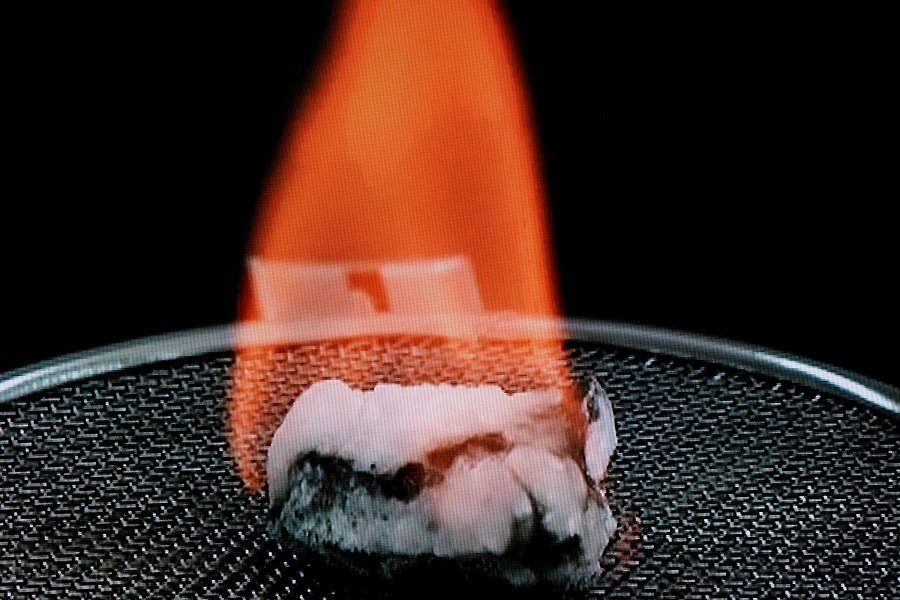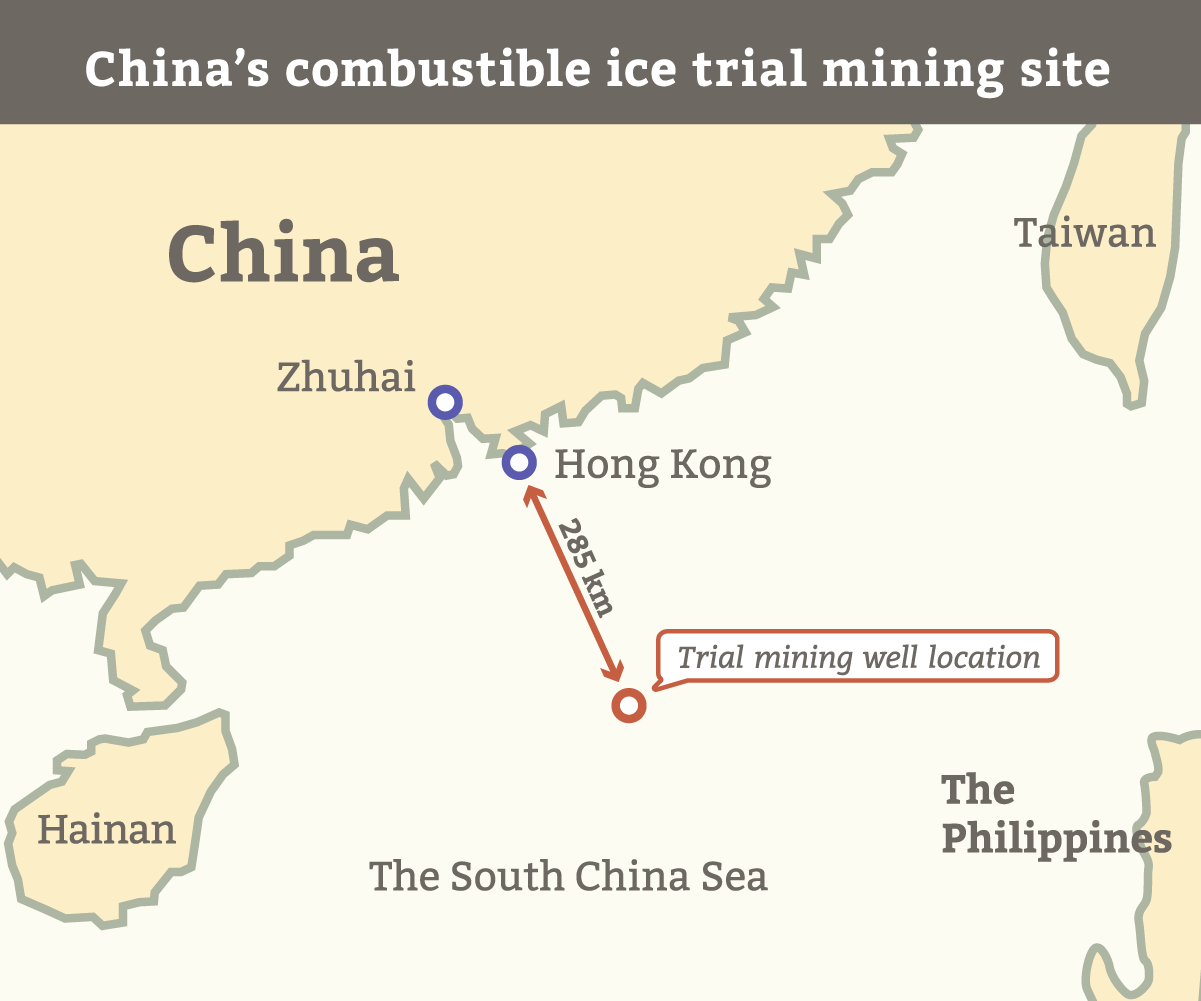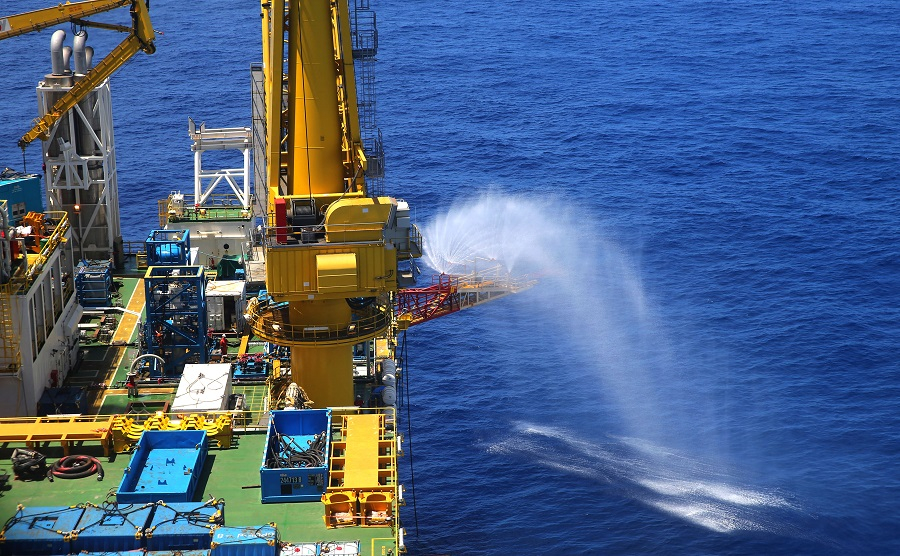“Combustible ice,” a clean and highly efficient fuel with vast global reserves, is seen as an alternative energy source that could replace fossil fuels in the future. A technological breakthrough has enabled China to extract combustible ice successfully in the South China Sea, bringing mankind a crucial step closer towards developing a new energy source; even so, combustible ice still has a long and challenging way to go before its production can become commercially viable.
In 1934, workmen who were repairing a blocked natural gas pipeline in the former Soviet Union discovered an ice-like solid, later identified as what is commonly called combustible ice, also known by its scientific name “natural gas hydrate.” In May 2017, China had its first success in mining combustible ice from the Shenhu area (神狐海域) of the South China Sea, becoming the first nation in the world to mine combustible ice from the sea bed and achieve a steady and continuous output of natural gas.
After over 80 years of exploration and research, combustible ice - seen as the most promising green fuel for commercial exploitation in the 21st century - is poised to revolutionize the global energy regime. For those who are unfamiliar with combustible ice, let’s start by exploring the following: What is combustible ice? What sets it apart from other fuels?

An emerging green fuel
Combustible ice is formed by methane and water in high-pressure, low-temperature environments. A white or grey-coloured ice-like solid, it resembles snow and ice, yet can be combusted directly, hence the name “combustible ice.”
Four basic conditions are required for the formation of combustible ice: low temperature, high pressure and adequate supplies of methane gas and water; Explorations conducted so far indicate that some 97% of the world’s combustible ice is distributed throughout the ocean, while 3% is located within terrestrial permafrost areas. The South China Sea and the Tibetan Plateau permafrost regions both hold rich deposits of combustible ice.
An efficient and clean-burning fuel, combustible ice is easy to use and has high energy content; under normal conditions, a volume unit of combustible ice can release 164 volume units of methane gas; when combusted, the amount of energy it releases is several dozen times that of coal or oil of equal mass. Furthermore, it does not generate any residue or emissions after burning; only a small amount of carbon dioxide and water is formed during the process, thereby avoiding the thorny issue of pollution.
More importantly, there are vast reserves of combustible ice: The world’s total combustible ice reserve is estimated to be twice the size of the combined known reserves of all traditional fossil fuels. China’s seas hold the equivalent of up to 80 billion tons of oil in combustible ice reserves, enough to meet its needs at current consumption levels for the next 200 years. As an efficient, clean fuel with vast reserves, combustible ice’s prospects for future development are enormous.

Nevertheless, exploiting combustible ice is a global challenge. As combustible ice was formed under high-pressure and low temperature conditions, the difficulty lies in extracting it from such an environment in an orderly and safe manner. Combustible ice is found in clay and silt on the seabed. Should the drill hole fail to be completely watertight, seawater could rush in and force out the gases within, with catastrophic consequences. Also, as combustible ice is mixed with gravel, sand production (flow of sand from a strata layer into the bore well, clogging its channel) also presents a challenging problem. Once extracted, methane gas from the combustible ice must also be tightly sealed to prevent leakage. Japan’s two trial attempts to mine combustible ice in 2013 and 2017 were both hampered by the problem of sand production.
From latecomer to leader: the “Chinese solution”
The United States pioneered the field of combustible ice, being the first nation to conduct exploration for and studies of combustible ice as early as the 1960s. “Bottom simulating reflector” (BSR), a technique introduced and developed by the United States for identifying the seismic signature of combustible ice, is widely used by the industry. In 2012, using a technique that replaces combustible ice with carbon dioxide, the United States company ConocoPhillips harvested 30,000 cubic metres of methane in 30 days from the Alaskan permafrost area. However, little progress was made enabling extraction of combustible ice from the seabed at that time.
Japan had started conducting basic research on combustible ice in the 1970s, and collected samples of combustible ice from the Nankai Trough near Shikoku in 1990. In 2001, the Japanese government initiated an 18-year plan to exploit combustible ice; in 2013, using a depressurization method, it managed to extract 119,000 cubic metres of methane gas at a steady rate from the sea off the coast of Aichi Prefecture, becoming the first country in the world to possess technology for unearthing combustible ice reserves from the seabed. However, due to sand production and poor weather, they were forced to suspend the operation after just six days.
China, a newcomer to the scene compared with Japan and the United States, did not launch its first official studies of combustible ice in the South China Sea and terrestrial permafrost regions until 1999. In 2004, to better support the exploration activities of scientific expedition teams, China officially established under the Chinese Academy of Sciences (中科院) a Guangzhou Centre for Gas Hydrate Research (廣州天然氣水合物研究中心), the nation’s first research centre on combustible ice.
After many years of national research and development, China obtained its first combustible ice samples via drilling tests conducted at the Shenhu area (神狐海域) of the South China Sea in 2007, becoming the fourth nation after the United States, Japan and India to obtain physical samples of combustible ice from the seabed. In 2011, China successfully induced the breakdown of combustible ice reserves 130 to 400 metres underground, releasing it as natural gas from the permafrost region of Qinghai (青海) Province’s Qilian Mountains (祁連山).
In 2013, scientific expedition teams conducted drilling tests in waters east of the Pearl River Mouth Basin (珠江口盆地) and obtained samples of numerous types of highly saturated hydrates, confirming for the first time that the region possesses combustible ice reserves exceeding 100 billion cubic metres in size, and is currently the region with the highest ore saturation in the world.
On May 10, 2017, China succeeded in test mining and flaring natural gas released from combustible ice deposits at a depth of 1,266 metres under water at the Shenhu area of the South China Sea. The body of combustible ice ore was buried at 203 to 277 metres below seabed. Once the gas was ignited and flaring, the mining operation lasted for 60 days, achieving a total output of 300,000 cubic metres of natural gas.

Test mining pulled off the twin feats of a) extracting gas hydrates hosted in fine-grained sandy clay, the most notorious reservoir to mine from, and b) setting a world record for the longest gas extraction period and highest total yield. These success can be attributed to the innovative Stratigraphic Fluid Extraction Method developed by the scientific research team. The method adopted involved pumping out a liquefied mass then extracting the gas by separating it from the water and sediment, instead of extracting gas by depressurization alone. This improved technique avoids problems like sand production and low permeability commonly encountered in combustible ice mining, keeping the wellbore passageway clear and output stable. It also ensures that the surrounding seawater and atmosphere remain pollution-free. No geological disasters were triggered throughout the trial mining process.
“Once we have refined the technology, it can be used to extract combustible ice in most regions on Earth and can be a helpful model for other countries. The future application prospects of this ‘Chinese solution’ will be endless,” said Lu Hailong (盧海龍), the chief scientist of the trial mining operation.
The British Broadcasting Corporation (BBC) hailed China’s success, describing the combustible ice under the South China Sea as the key to future global energy supplies, and China’s breakthrough as the first step on a long journey.

When can we start using combustible ice?
Now that a process for the continuous and stable extraction of combustible ice has been successfully devised, does it herald the coming of an “age of combustible ice?” In reality, things are not quite so simple.
There are still many who are concerned that mining combustible ice could lead to environmental problems, for, if not properly conducted, the operations might release methane gas into the atmosphere as a pollutant and exacerbate global climate change; it might also trigger geological disasters such as mass collapse of the ocean floor and slope failures, which would in turn induce earthquakes and tsunamis.
Addressing such concerns, Liang Qianyong (梁前勇), senior engineer of the Guangzhou Marine Geological Survey Bureau (廣州海洋地質調查局), explained: with current levels of scientific technology, we are capable of maintaining the exploitation of combustible ice within safe operating limits. To start with, combustible ice buried within sediment in the seabed is relatively stable unless acted on by an external force; i.e. when mining brings on changes in pressure and temperature in the vicinity of the ice and triggers decomposition. Moreover, as the combustible ice was deposited in a relatively thin layer and has a lengthy gas production cycle, changes to the seabed would take place very slowly during the course of mining. In addition, engineers will devise an optimal extraction plan and make use of relatively mature extraction techniques, thus minimizing the possibility of a man-made disaster to the greatest extent. Lastly, most of the methane released during the displacement of sediment and water would be consumed by bacteria in the natural environment, and is unlikely to enter shallow waters, let alone the atmosphere. He believes that many of the safety and environmental concerns over combustible ice are mainly theory-based speculations in need of being technically validated.
Of greater and more practical import is the high cost of extracting and utilizing combustible ice. It will be some time before it becomes commercially viable.
The high cost of exploiting combustible ice is a major disadvantage for various countries, and has led to repeated delays in plans to commercialize the resource. China’s per cubic metre cost for mining combustible ice from Shenhu waters is lower than that of Japan’s under similar circumstances, yet still higher than that of the United States. In addition, the daily output that has been achieved so far falls woefully short of what is needed to sustain combustible ice as an industry, meaning that exploitation is not commercially viable at present. Moreover, the domestic and foreign production chains necessary for the development and use of combustible ice are still incomplete and the overall market environment is immature.
In view of these circumstances. Lu Hailong and other scientists have estimated that the commercial development of combustible ice may only be achieved 15 to 20 years hence.
The trial mining successes so far have helped mankind open a new chapter in the development of combustible ice as a new fuel, and catapulted China to the forefront of the field. Realistically it will be a long time before this “fuel of the future” is fully developed and can rightfully claim its title.
References:
Research Status of Combustible Ice and the Bottleneck of its Commercial Exploitation (可燃冰研究現狀及商業化開採瓶頸) by Fu Yarong (付亞榮) Oil Drilling & Production Technology (石油鑽採工藝), 2018 Issue 1
Exploitation of Combustible Ice can be Maintained Within Safe Operating Limits (可燃冰開發可以控制在安全範圍內) by Liang Qianyong (梁前勇), Yu Zhe (于哲), The Chinese Newspaper of Land and Resources (中國國土資源報) July 5, 2017
Unveiling the Mystery of Combustible Ice (揭開可燃冰神秘面紗) by Liang Jinqiang (梁金強) The Chinese Newspaper of Land and Resources June 15, 2017
Domestic Combustible Ice Reserves Can Power Us for Over a Century, Commercial Exploitation Achievable 15 to 20 Years Down the Road (我國可燃冰資源可用百年以上 商業開發還需15到20年時間) Economic Information Daily (經濟參考報) June 5, 2017
Combustible Ice Test Mine Closed After 60-Day Trial, Sets World Records for Production Time and Total Yield (中國可燃冰試採60天關井,產氣時長和總量創世界紀錄) thepaper.cn (澎湃新聞) July 9, 2017



